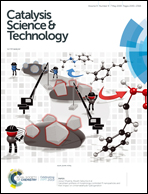Cu-Based mixed metal oxides for an efficient photothermal catalysis of the water-gas shift reaction†
Abstract
Cu-Based catalysts are currently used for the low-temperature water-gas shift (WGS) reaction, where the metallic Cu acts as the main active site. Under light irradiation, the Cu nanoparticles absorb photons, and electrons are promoted to the excited state. Then, the rapid relaxation of those excited electrons further drives the excited lattice phonon mode to generate heat in the local environment. This leads to a relatively high temperature at the catalytic reaction site. Herein, Cu-based catalysts were fabricated, and their catalytic activities for the WGS reaction were tested under the light irradiation of a xenon lamp without any additional heat treatment. Time-dependent temperature monitoring revealed that the temperature reached at 300 °C in 3 min, and then stabilized at ca. 350 °C for those Cu catalysts, which provided sufficient energy to overcome the energetic barrier and initiate the WGS reaction. Various metal oxides were optimized to function as the support, and Cu–ZnO exhibited the highest photothermal catalytic activity, which could produce 9.5 mmol of H2 in 30 min and had the CO conversion efficiency as high as 86.8%. The superior catalytic activity was ascribed to the strengthened interaction between the intermediate formate species and the partially oxidized Zn in the Cu–ZnO catalyst.



 Please wait while we load your content...
Please wait while we load your content...